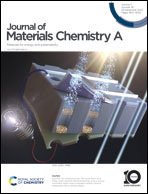Metal–organic framework derived tunnel structured MnO as the cathode material for high performance aqueous zinc-ion batteries†
Abstract
MnO2 materials with different tunnel structures have received considerable attention as cathode materials for aqueous zinc-ion batteries (ZIBs), but most of their electrochemical reactions are still limited to Mn4+ ↔ Mn3+ due to the lack of large and stable tunnels and the inevitable dissolution of Mn2+. In contrast, MnO has received less attention due to the lack of tunnels. Here, we propose a novel strategy to synthesize a layered metal–organic framework with hexagonal tunnels (L-MOF-HT) by combining MOF-on-MOF epitaxial growth with a dissolution–recrystallization process. The L-MOF-HT derived tunnel structured MnO@carbon framework (t-MnO@C) retains the hexagonal tunnel of L-MOF-HT, whose tunnels are 0.55 nm in size and facilitate the two-electron redox reaction of Mn2+ ↔ Mn4+. MnO is confined within the carbon framework by the Mn–O–C bonds, preventing the dissolution of Mn2+ in the electrolyte. In addition, carbonized MOF-5 is coated on zinc foil (C-MOF-5@Zn) to act as an anode, which can suppress the zinc dendrites to truly evaluate the electrochemical performance of the t-MnO@C cathode. The MnO in the t-MnO@C cathode shows a high specific capacity of 743 mA h g−1 at 0.05 A g−1 in the first discharge cycle, which is close to its theoretical capacity of 755 mA h g−1 based on the two-electron reaction of Mn2+ ↔ Mn4+. Furthermore, the t-MnO@C cathode exhibits an excellent cycling stability with 97% capacity retention after 20 000 cycles at 5 A g−1.



 Please wait while we load your content...
Please wait while we load your content...